run flat JEEP CHEROKEE 2021 Owner handbook (in English)
[x] Cancel search | Manufacturer: JEEP, Model Year: 2021, Model line: CHEROKEE, Model: JEEP CHEROKEE 2021Pages: 332, PDF Size: 8.87 MB
Page 102 of 332
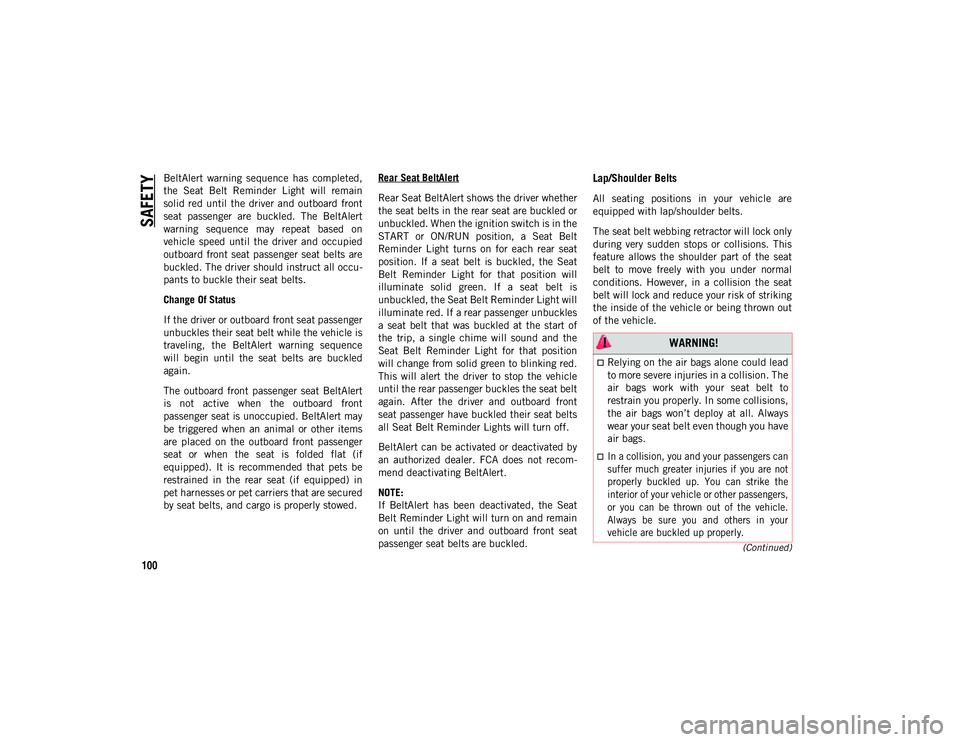
SAFETY
100
(Continued)
BeltAlert warning sequence has completed,
the Seat Belt Reminder Light will remain
solid red until the driver and outboard front
seat passenger are buckled. The BeltAlert
warning sequence may repeat based on
vehicle speed until the driver and occupied
outboard front seat passenger seat belts are
buckled. The driver should instruct all occu-
pants to buckle their seat belts.
Change Of Status
If the driver or outboard front seat passenger
unbuckles their seat belt while the vehicle is
traveling, the BeltAlert warning sequence
will begin until the seat belts are buckled
again.
The outboard front passenger seat BeltAlert
is not active when the outboard front
passenger seat is unoccupied. BeltAlert may
be triggered when an animal or other items
are placed on the outboard front passenger
seat or when the seat is folded flat (if
equipped). It is recommended that pets be
restrained in the rear seat (if equipped) in
pet harnesses or pet carriers that are secured
by seat belts, and cargo is properly stowed. Rear Seat BeltAlert
Rear Seat BeltAlert shows the driver whether
the seat belts in the rear seat are buckled or
unbuckled. When the ignition switch is in the
START or ON/RUN position, a Seat Belt
Reminder Light turns on for each rear seat
position. If a seat belt is buckled, the Seat
Belt Reminder Light for that position will
illuminate solid green. If a seat belt is
unbuckled, the Seat Belt Reminder Light will
illuminate red. If a rear passenger unbuckles
a seat belt that was buckled at the start of
the trip, a single chime will sound and the
Seat Belt Reminder Light for that position
will change from solid green to blinking red.
This will alert the driver to stop the vehicle
until the rear passenger buckles the seat belt
again. After the driver and outboard front
seat passenger have buckled their seat belts
all Seat Belt Reminder Lights will turn off.
BeltAlert can be activated or deactivated by
an authorized dealer. FCA does not recom
-
mend deactivating BeltAlert.
NOTE:
If BeltAlert has been deactivated, the Seat
Belt Reminder Light will turn on and remain
on until the driver and outboard front seat
passenger seat belts are buckled.
Lap/Shoulder Belts
All seating positions in your vehicle are
equipped with lap/shoulder belts.
The seat belt webbing retractor will lock only
during very sudden stops or collisions. This
feature allows the shoulder part of the seat
belt to move freely with you under normal
conditions. However, in a collision the seat
belt will lock and reduce your risk of striking
the inside of the vehicle or being thrown out
of the vehicle.
WARNING!
Relying on the air bags alone could lead
to more severe injuries in a collision. The
air bags work with your seat belt to
restrain you properly. In some collisions,
the air bags won’t deploy at all. Always
wear your seat belt even though you have
air bags.
In a collision, you and your passengers can
suffer much greater injuries if you are not
properly buckled up. You can strike the
interior of your vehicle or other passengers,
or you can be thrown out of the vehicle.
Always be sure you and others in your
vehicle are buckled up properly.
2020_JEEP_CHEROKEE_UG_RHD_UK.book Page 100
Page 110 of 332
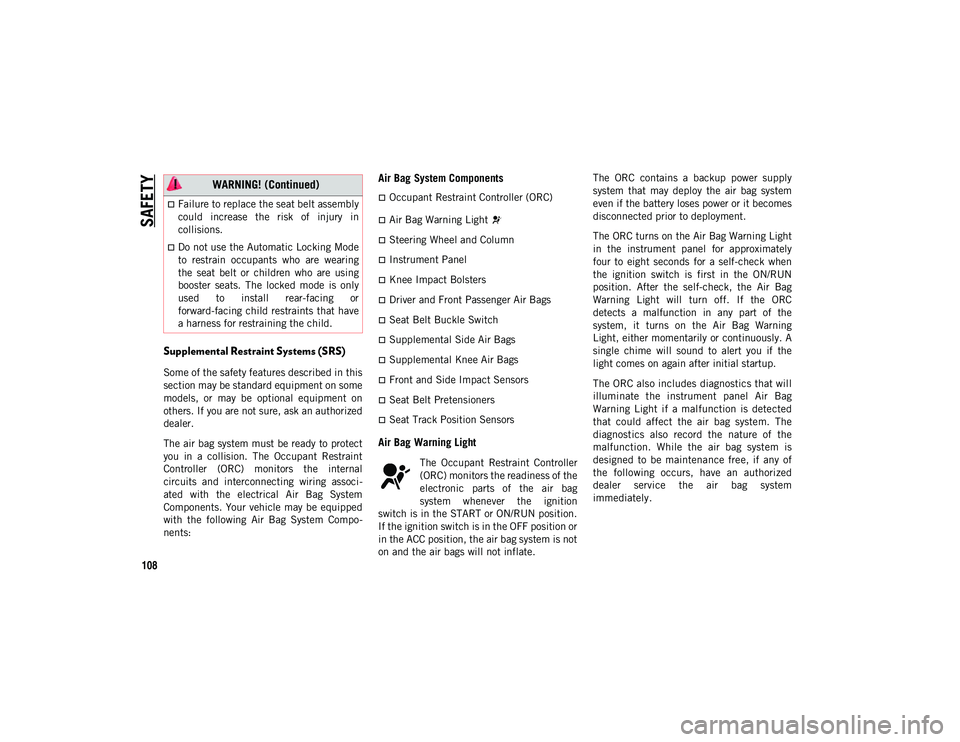
SAFETY
108
Supplemental Restraint Systems (SRS)
Some of the safety features described in this
section may be standard equipment on some
models, or may be optional equipment on
others. If you are not sure, ask an authorized
dealer.
The air bag system must be ready to protect
you in a collision. The Occupant Restraint
Controller (ORC) monitors the internal
circuits and interconnecting wiring associ-
ated with the electrical Air Bag System
Components. Your vehicle may be equipped
with the following Air Bag System Compo -
nents:
Air Bag System Components
Occupant Restraint Controller (ORC)
Air Bag Warning Light
Steering Wheel and Column
Instrument Panel
Knee Impact Bolsters
Driver and Front Passenger Air Bags
Seat Belt Buckle Switch
Supplemental Side Air Bags
Supplemental Knee Air Bags
Front and Side Impact Sensors
Seat Belt Pretensioners
Seat Track Position Sensors
Air Bag Warning Light
The Occupant Restraint Controller
(ORC) monitors the readiness of the
electronic parts of the air bag
system whenever the ignition
switch is in the START or ON/RUN position.
If the ignition switch is in the OFF position or
in the ACC position, the air bag system is not
on and the air bags will not inflate. The ORC contains a backup power supply
system that may deploy the air bag system
even if the battery loses power or it becomes
disconnected prior to deployment.
The ORC turns on the Air Bag Warning Light
in the instrument panel for approximately
four to eight seconds for a self-check when
the ignition switch is first in the ON/RUN
position. After the self-check, the Air Bag
Warning Light will turn off. If the ORC
detects a malfunction in any part of the
system, it turns on the Air Bag Warning
Light, either momentarily or continuously. A
single chime will sound to alert you if the
light comes on again after initial startup.
The ORC also includes diagnostics that will
illuminate the instrument panel Air Bag
Warning Light if a malfunction is detected
that could affect the air bag system. The
diagnostics also record the nature of the
malfunction. While the air bag system is
designed to be maintenance free, if any of
the following occurs, have an authorized
dealer service the air bag system
immediately.
Failure to replace the seat belt assembly
could increase the risk of injury in
collisions.
Do not use the Automatic Locking Mode
to restrain occupants who are wearing
the seat belt or children who are using
booster seats. The locked mode is only
used to install rear-facing or
forward-facing child restraints that have
a harness for restraining the child.
WARNING! (Continued)
2020_JEEP_CHEROKEE_UG_RHD_UK.book Page 108
Page 111 of 332
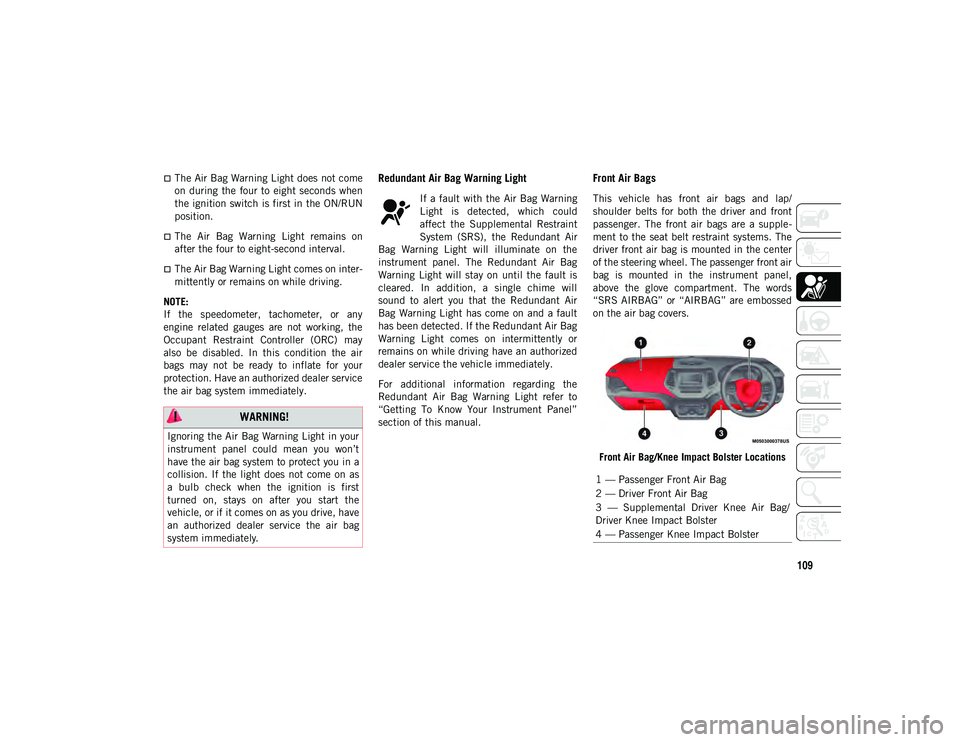
109
The Air Bag Warning Light does not come
on during the four to eight seconds when
the ignition switch is first in the ON/RUN
position.
The Air Bag Warning Light remains on
after the four to eight-second interval.
The Air Bag Warning Light comes on inter-
mittently or remains on while driving.
NOTE:
If the speedometer, tachometer, or any
engine related gauges are not working, the
Occupant Restraint Controller (ORC) may
also be disabled. In this condition the air
bags may not be ready to inflate for your
protection. Have an authorized dealer service
the air bag system immediately.
Redundant Air Bag Warning Light
If a fault with the Air Bag Warning
Light is detected, which could
affect the Supplemental Restraint
System (SRS), the Redundant Air
Bag Warning Light will illuminate on the
instrument panel. The Redundant Air Bag
Warning Light will stay on until the fault is
cleared. In addition, a single chime will
sound to alert you that the Redundant Air
Bag Warning Light has come on and a fault
has been detected. If the Redundant Air Bag
Warning Light comes on intermittently or
remains on while driving have an authorized
dealer service the vehicle immediately.
For additional information regarding the
Redundant Air Bag Warning Light refer to
“Getting To Know Your Instrument Panel”
section of this manual.
Front Air Bags
This vehicle has front air bags and lap/
shoulder belts for both the driver and front
passenger. The front air bags are a supple -
ment to the seat belt restraint systems. The
driver front air bag is mounted in the center
of the steering wheel. The passenger front air
bag is mounted in the instrument panel,
above the glove compartment. The words
“SRS AIRBAG” or “AIRBAG” are embossed
on the air bag covers.
Front Air Bag/Knee Impact Bolster Locations
WARNING!
Ignoring the Air Bag Warning Light in your
instrument panel could mean you won’t
have the air bag system to protect you in a
collision. If the light does not come on as
a bulb check when the ignition is first
turned on, stays on after you start the
vehicle, or if it comes on as you drive, have
an authorized dealer service the air bag
system immediately.
1 — Passenger Front Air Bag
2 — Driver Front Air Bag
3 — Supplemental Driver Knee Air Bag/
Driver Knee Impact Bolster
4 — Passenger Knee Impact Bolster
2020_JEEP_CHEROKEE_UG_RHD_UK.book Page 109
Page 183 of 332
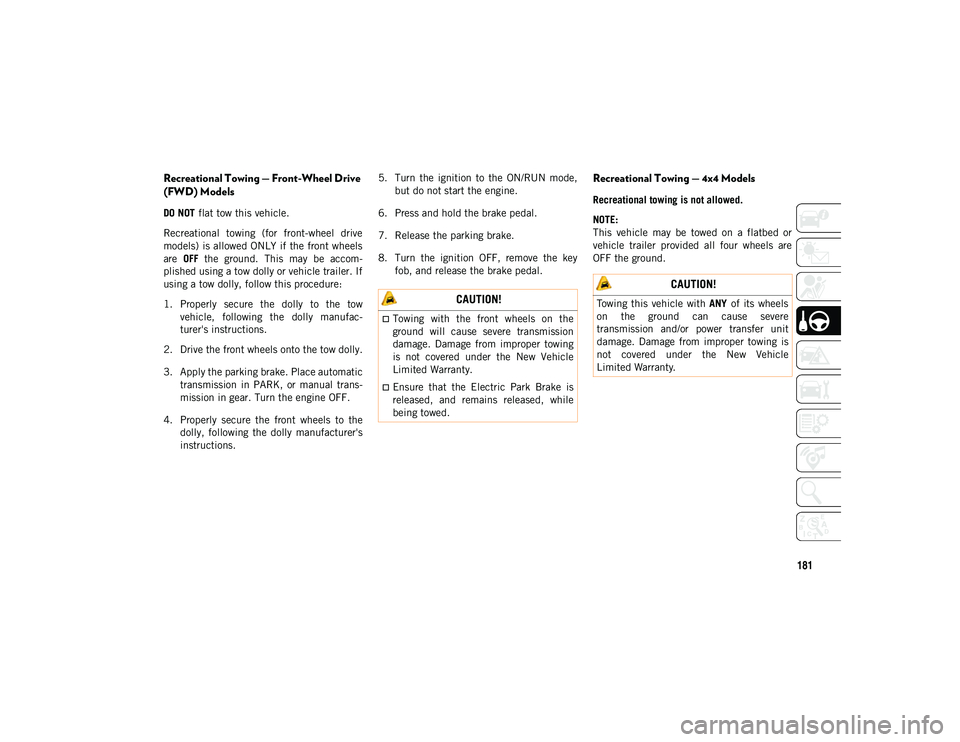
181
Recreational Towing — Front-Wheel Drive
(FWD) Models
DO NOT flat tow this vehicle.
Recreational towing (for front-wheel drive
models) is allowed ONLY if the front wheels
are OFF the ground. This may be accom -
plished using a tow dolly or vehicle trailer. If
using a tow dolly, follow this procedure:
1. Properly secure the dolly to the tow vehicle, following the dolly manufac -
turer's instructions.
2. Drive the front wheels onto the tow dolly.
3. Apply the parking brake. Place automatic transmission in PARK, or manual trans -
mission in gear. Turn the engine OFF.
4. Properly secure the front wheels to the dolly, following the dolly manufacturer's
instructions. 5. Turn the ignition to the ON/RUN mode,
but do not start the engine.
6. Press and hold the brake pedal.
7. Release the parking brake.
8. Turn the ignition OFF, remove the key fob, and release the brake pedal.
Recreational Towing — 4x4 Models
Recreational towing is not allowed.
NOTE:
This vehicle may be towed on a flatbed or
vehicle trailer provided all four wheels are
OFF the ground.
CAUTION!
Towing with the front wheels on the
ground will cause severe transmission
damage. Damage from improper towing
is not covered under the New Vehicle
Limited Warranty.
Ensure that the Electric Park Brake is
released, and remains released, while
being towed.
CAUTION!
Towing this vehicle with ANY of its wheels
on the ground can cause severe
transmission and/or power transfer unit
damage. Damage from improper towing is
not covered under the New Vehicle
Limited Warranty.
2020_JEEP_CHEROKEE_UG_RHD_UK.book Page 181
Page 197 of 332
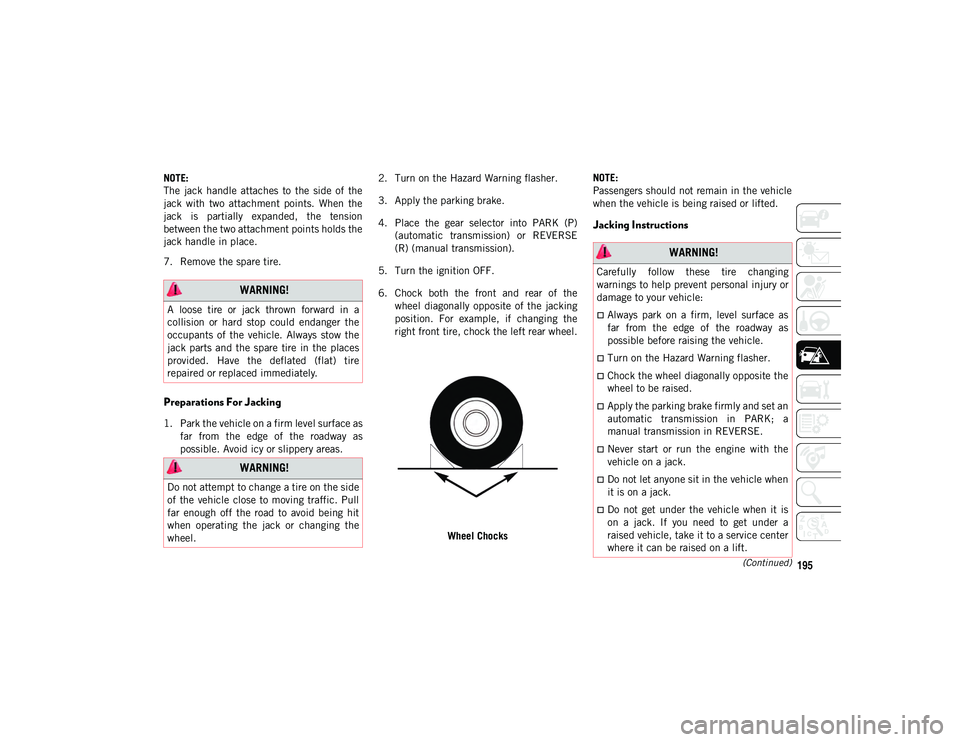
195(Continued)
NOTE:
The jack handle attaches to the side of the
jack with two attachment points. When the
jack is partially expanded, the tension
between the two attachment points holds the
jack handle in place.
7. Remove the spare tire.
Preparations For Jacking
1. Park the vehicle on a firm level surface asfar from the edge of the roadway as
possible. Avoid icy or slippery areas. 2. Turn on the Hazard Warning flasher.
3. Apply the parking brake.
4. Place the gear selector into PARK (P)
(automatic transmission) or REVERSE
(R) (manual transmission).
5. Turn the ignition OFF.
6. Chock both the front and rear of the wheel diagonally opposite of the jacking
position. For example, if changing the
right front tire, chock the left rear wheel.
Wheel Chocks NOTE:
Passengers should not remain in the vehicle
when the vehicle is being raised or lifted.
Jacking Instructions
WARNING!
A loose tire or jack thrown forward in a
collision or hard stop could endanger the
occupants of the vehicle. Always stow the
jack parts and the spare tire in the places
provided. Have the deflated (flat) tire
repaired or replaced immediately.
WARNING!
Do not attempt to change a tire on the side
of the vehicle close to moving traffic. Pull
far enough off the road to avoid being hit
when operating the jack or changing the
wheel.
WARNING!
Carefully follow these tire changing
warnings to help prevent personal injury or
damage to your vehicle:
Always park on a firm, level surface as
far from the edge of the roadway as
possible before raising the vehicle.
Turn on the Hazard Warning flasher.
Chock the wheel diagonally opposite the
wheel to be raised.
Apply the parking brake firmly and set an
automatic transmission in PARK; a
manual transmission in REVERSE.
Never start or run the engine with the
vehicle on a jack.
Do not let anyone sit in the vehicle when
it is on a jack.
Do not get under the vehicle when it is
on a jack. If you need to get under a
raised vehicle, take it to a service center
where it can be raised on a lift.
2020_JEEP_CHEROKEE_UG_RHD_UK.book Page 195
Page 207 of 332
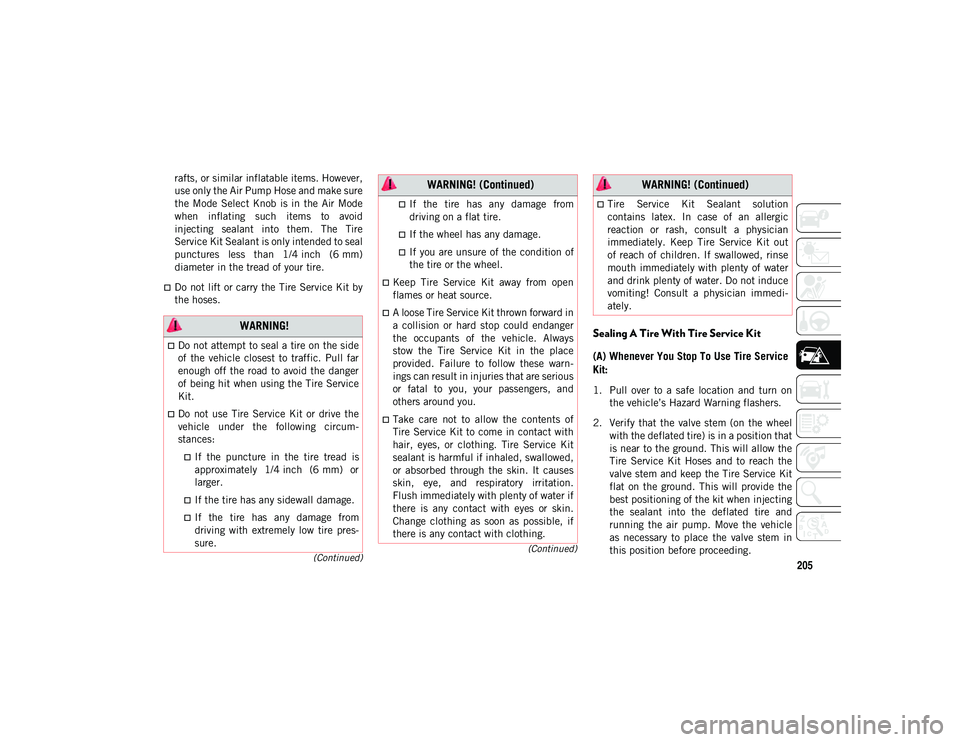
205
(Continued)
(Continued)
rafts, or similar inflatable items. However,
use only the Air Pump Hose and make sure
the Mode Select Knob is in the Air Mode
when inflating such items to avoid
injecting sealant into them. The Tire
Service Kit Sealant is only intended to seal
punctures less than 1/4 inch (6 mm)
diameter in the tread of your tire.
Do not lift or carry the Tire Service Kit by
the hoses.
Sealing A Tire With Tire Service Kit
(A) Whenever You Stop To Use Tire Service
Kit:
1. Pull over to a safe location and turn on the vehicle’s Hazard Warning flashers.
2. Verify that the valve stem (on the wheel with the deflated tire) is in a position that
is near to the ground. This will allow the
Tire Service Kit Hoses and to reach the
valve stem and keep the Tire Service Kit
flat on the ground. This will provide the
best positioning of the kit when injecting
the sealant into the deflated tire and
running the air pump. Move the vehicle
as necessary to place the valve stem in
this position before proceeding.
WARNING!
Do not attempt to seal a tire on the side
of the vehicle closest to traffic. Pull far
enough off the road to avoid the danger
of being hit when using the Tire Service
Kit.
Do not use Tire Service Kit or drive the
vehicle under the following circum -
stances:
If the puncture in the tire tread is
approximately 1/4 inch (6 mm) or
larger.
If the tire has any sidewall damage.
If the tire has any damage from driving with extremely low tire pres-
sure.
If the tire has any damage fromdriving on a flat tire.
If the wheel has any damage.
If you are unsure of the condition ofthe tire or the wheel.
Keep Tire Service Kit away from open
flames or heat source.
A loose Tire Service Kit thrown forward in
a collision or hard stop could endanger
the occupants of the vehicle. Always
stow the Tire Service Kit in the place
provided. Failure to follow these warn -
ings can result in injuries that are serious
or fatal to you, your passengers, and
others around you.
Take care not to allow the contents of
Tire Service Kit to come in contact with
hair, eyes, or clothing. Tire Service Kit
sealant is harmful if inhaled, swallowed,
or absorbed through the skin. It causes
skin, eye, and respiratory irritation.
Flush immediately with plenty of water if
there is any contact with eyes or skin.
Change clothing as soon as possible, if
there is any contact with clothing.
WARNING! (Continued)
Tire Service Kit Sealant solution
contains latex. In case of an allergic
reaction or rash, consult a physician
immediately. Keep Tire Service Kit out
of reach of children. If swallowed, rinse
mouth immediately with plenty of water
and drink plenty of water. Do not induce
vomiting! Consult a physician immedi -
ately.
WARNING! (Continued)
2020_JEEP_CHEROKEE_UG_RHD_UK.book Page 205
Page 208 of 332
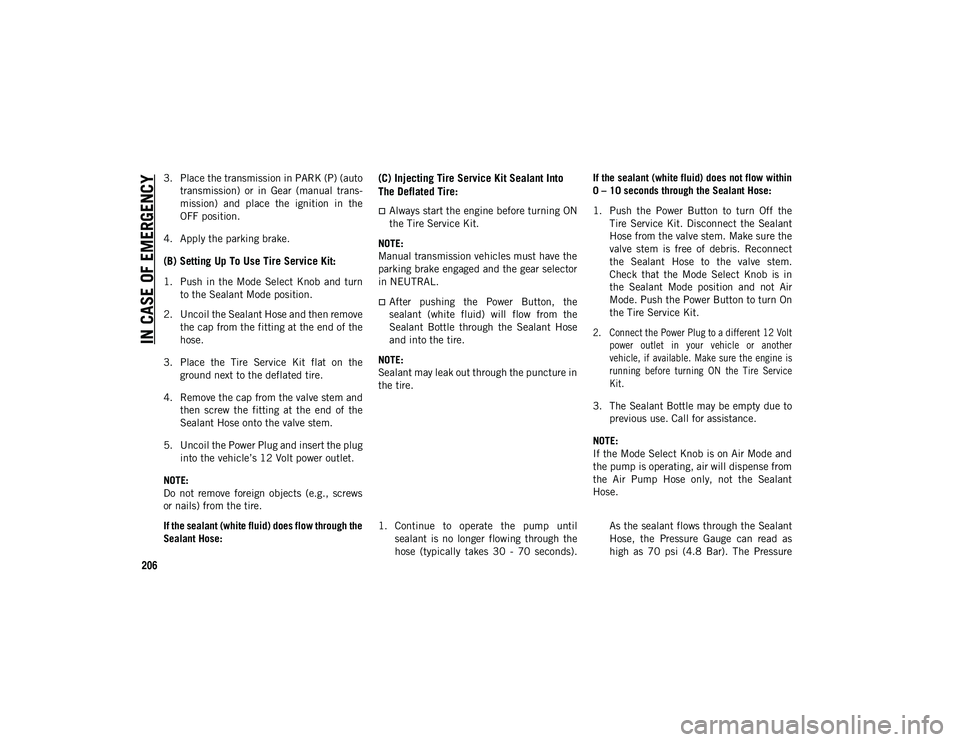
IN CASE OF EMERGENCY
206
3. Place the transmission in PARK (P) (autotransmission) or in Gear (manual trans -
mission) and place the ignition in the
OFF position.
4. Apply the parking brake.
(B) Setting Up To Use Tire Service Kit:
1. Push in the Mode Select Knob and turn to the Sealant Mode position.
2. Uncoil the Sealant Hose and then remove the cap from the fitting at the end of the
hose.
3. Place the Tire Service Kit flat on the ground next to the deflated tire.
4. Remove the cap from the valve stem and then screw the fitting at the end of the
Sealant Hose onto the valve stem.
5. Uncoil the Power Plug and insert the plug into the vehicle’s 12 Volt power outlet.
NOTE:
Do not remove foreign objects (e.g., screws
or nails) from the tire.
(C) Injecting Tire Service Kit Sealant Into
The Deflated Tire:
Always start the engine before turning ON
the Tire Service Kit.
NOTE:
Manual transmission vehicles must have the
parking brake engaged and the gear selector
in NEUTRAL.
After pushing the Power Button, the
sealant (white fluid) will flow from the
Sealant Bottle through the Sealant Hose
and into the tire.
NOTE:
Sealant may leak out through the puncture in
the tire. If the sealant (white fluid) does not flow within
0 – 10 seconds through the Sealant Hose:
1. Push the Power Button to turn Off the
Tire Service Kit. Disconnect the Sealant
Hose from the valve stem. Make sure the
valve stem is free of debris. Reconnect
the Sealant Hose to the valve stem.
Check that the Mode Select Knob is in
the Sealant Mode position and not Air
Mode. Push the Power Button to turn On
the Tire Service Kit.
2. Connect the Power Plug to a different 12 Volt power outlet in your vehicle or another
vehicle, if available. Make sure the engine is
running before turning ON the Tire Service
Kit.
3. The Sealant Bottle may be empty due to previous use. Call for assistance.
NOTE:
If the Mode Select Knob is on Air Mode and
the pump is operating, air will dispense from
the Air Pump Hose only, not the Sealant
Hose.
If the sealant (white fluid) does flow through the
Sealant Hose: 1. Continue to operate the pump until
sealant is no longer flowing through the
hose (typically takes 30 - 70 seconds). As the sealant flows through the Sealant
Hose, the Pressure Gauge can read as
high as 70 psi (4.8 Bar). The Pressure
2020_JEEP_CHEROKEE_UG_RHD_UK.book Page 206
Page 217 of 332
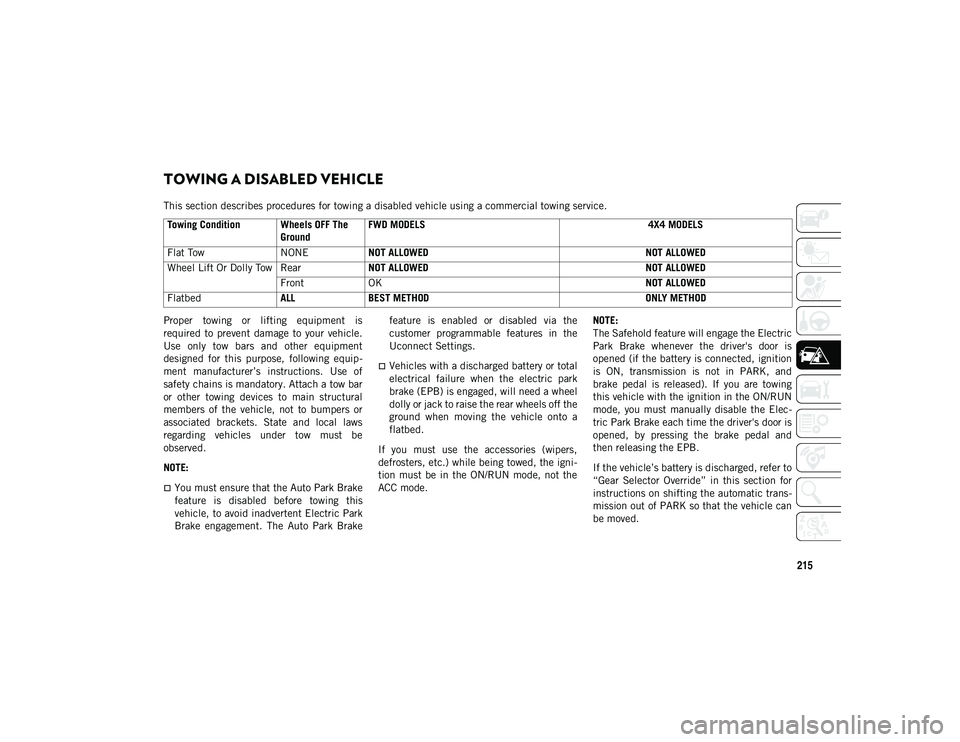
215
TOWING A DISABLED VEHICLE
This section describes procedures for towing a disabled vehicle using a commercial towing service.
Proper towing or lifting equipment is
required to prevent damage to your vehicle.
Use only tow bars and other equipment
designed for this purpose, following equip-
ment manufacturer’s instructions. Use of
safety chains is mandatory. Attach a tow bar
or other towing devices to main structural
members of the vehicle, not to bumpers or
associated brackets. State and local laws
regarding vehicles under tow must be
observed.
NOTE:
You must ensure that the Auto Park Brake
feature is disabled before towing this
vehicle, to avoid inadvertent Electric Park
Brake engagement. The Auto Park Brake feature is enabled or disabled via the
customer programmable features in the
Uconnect Settings.
Vehicles with a discharged battery or total
electrical failure when the electric park
brake (EPB) is engaged, will need a wheel
dolly or jack to raise the rear wheels off the
ground when moving the vehicle onto a
flatbed.
If you must use the accessories (wipers,
defrosters, etc.) while being towed, the igni -
tion must be in the ON/RUN mode, not the
ACC mode. NOTE:
The Safehold feature will engage the Electric
Park Brake whenever the driver's door is
opened (if the battery is connected, ignition
is ON, transmission is not in PARK, and
brake pedal is released). If you are towing
this vehicle with the ignition in the ON/RUN
mode, you must manually disable the Elec
-
tric Park Brake each time the driver's door is
opened, by pressing the brake pedal and
then releasing the EPB.
If the vehicle’s battery is discharged, refer to
“Gear Selector Override” in this section for
instructions on shifting the automatic trans -
mission out of PARK so that the vehicle can
be moved.
Towing Condition Wheels OFF The
GroundFWD MODELS
4X4 MODELS
Flat Tow NONENOT ALLOWED NOT ALLOWED
Wheel Lift Or Dolly Tow Rear NOT ALLOWED NOT ALLOWED
Front OK NOT ALLOWED
Flatbed ALLBEST METHOD ONLY METHOD
2020_JEEP_CHEROKEE_UG_RHD_UK.book Page 215
Page 245 of 332
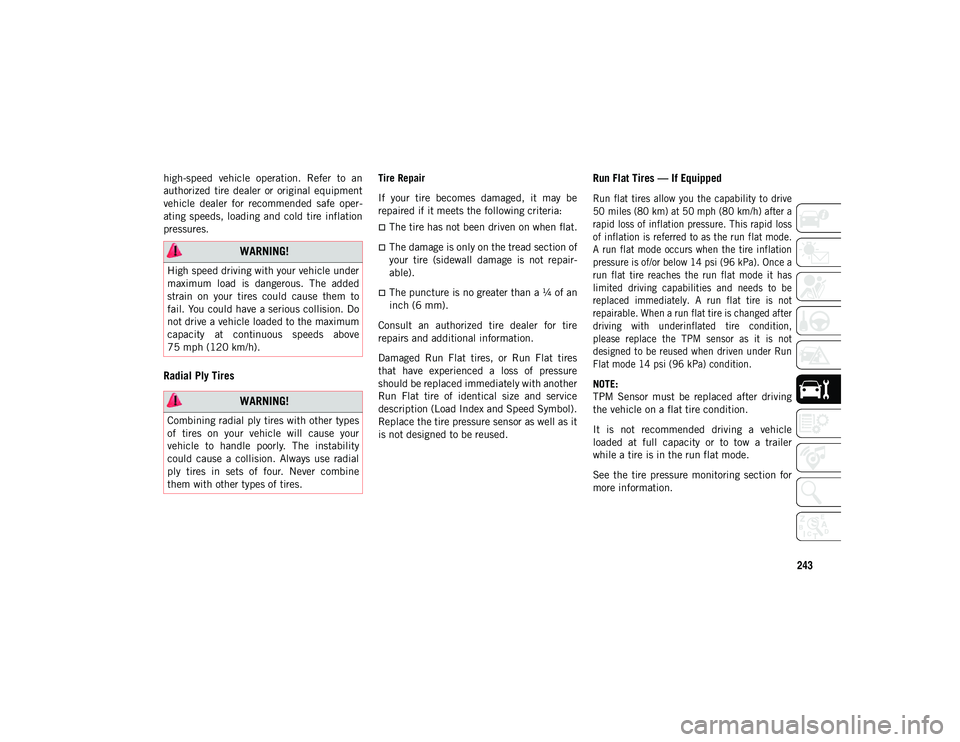
243
high-speed vehicle operation. Refer to an
authorized tire dealer or original equipment
vehicle dealer for recommended safe oper-
ating speeds, loading and cold tire inflation
pressures.
Radial Ply Tires
Tire Repair
If your tire becomes damaged, it may be
repaired if it meets the following criteria:
The tire has not been driven on when flat.
The damage is only on the tread section of
your tire (sidewall damage is not repair -
able).
The puncture is no greater than a ¼ of an
inch (6 mm).
Consult an authorized tire dealer for tire
repairs and additional information.
Damaged Run Flat tires, or Run Flat tires
that have experienced a loss of pressure
should be replaced immediately with another
Run Flat tire of identical size and service
description (Load Index and Speed Symbol).
Replace the tire pressure sensor as well as it
is not designed to be reused.
Run Flat Tires — If Equipped
Run flat tires allow you the capability to drive
50 miles (80 km) at 50 mph (80 km/h) after a
rapid loss of inflation pressure. This rapid loss
of inflation is referred to as the run flat mode.
A run flat mode occurs when the tire inflation
pressure is of/or below 14 psi (96 kPa). Once a
run flat tire reaches the run flat mode it has
limited driving capabilities and needs to be
replaced immediately. A run flat tire is not
repairable. When a run flat tire is changed after
driving with underinflated tire condition,
please replace the TPM sensor as it is not
designed to be reused when driven under Run
Flat mode 14 psi (96 kPa) condition.
NOTE:
TPM Sensor must be replaced after driving
the vehicle on a flat tire condition.
It is not recommended driving a vehicle
loaded at full capacity or to tow a trailer
while a tire is in the run flat mode.
See the tire pressure monitoring section for
more information.
WARNING!
High speed driving with your vehicle under
maximum load is dangerous. The added
strain on your tires could cause them to
fail. You could have a serious collision. Do
not drive a vehicle loaded to the maximum
capacity at continuous speeds above
75 mph (120 km/h).
WARNING!
Combining radial ply tires with other types
of tires on your vehicle will cause your
vehicle to handle poorly. The instability
could cause a collision. Always use radial
ply tires in sets of four. Never combine
them with other types of tires.
2020_JEEP_CHEROKEE_UG_RHD_UK.book Page 243
Page 325 of 332
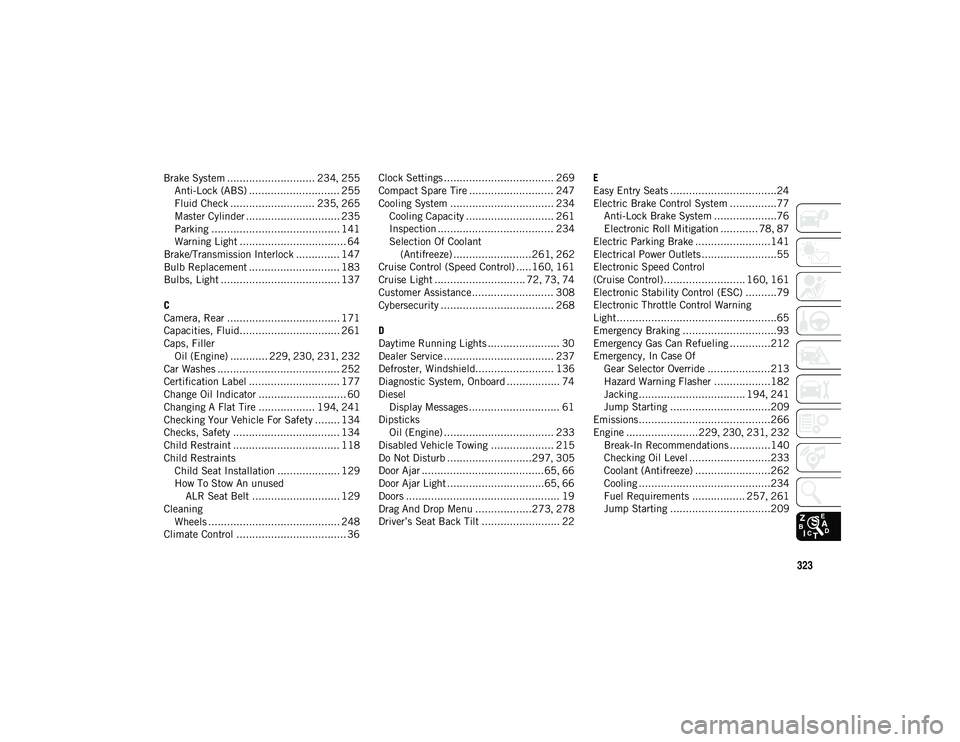
323
Brake System ............................ 234, 255
Anti-Lock (ABS) ............................. 255 Fluid Check ........................... 235 , 265
Master Cylinder .............................. 235
Parking ......................................... 141
Warning Light .................................. 64
Brake/Transmission Interlock .............. 147
Bulb Replacement ............................. 183
Bulbs, Light ...................................... 137
C
Camera, Rear .................................... 171
Capacities, Fluid................................ 261
Caps, Filler Oil (Engine) ............ 229 , 230 , 231 , 232
Car Washes ....................................... 252
Certification Label ............................. 177
Change Oil Indicator ............................ 60
Changing A Flat Tire .................. 194 , 241
Checking Your Vehicle For Safety ........ 134
Checks, Safety .................................. 134
Child Restraint .................................. 118
Child Restraints Child Seat Installation .................... 129
How To Stow An unused ALR Seat Belt ............................ 129
Cleaning Wheels .......................................... 248
Climate Control ................................... 36 Clock Settings ................................... 269
Compact Spare Tire ........................... 247
Cooling System ................................. 234
Cooling Capacity ............................ 261
Inspection ..................................... 234
Selection Of Coolant (Antifreeze) .........................261 , 262
Cruise Control (Speed Control) .....160 , 161
Cruise Light ............................. 72 , 73 , 74
Customer Assistance .......................... 308
Cybersecurity .................................... 268
D
Daytime Running Lights ....................... 30
Dealer Service ................................... 237
Defroster, Windshield......................... 136
Diagnostic System, Onboard ................. 74
Diesel Display Messages ............................. 61
Dipsticks Oil (Engine) ................................... 233
Disabled Vehicle Towing .................... 215
Do Not Disturb ...........................297 , 305
Door Ajar .......................................65 , 66
Door Ajar Light ...............................65 , 66
Doors ................................................. 19
Drag And Drop Menu ..................273 , 278
Driver’s Seat Back Tilt ......................... 22 E
Easy Entry Seats ..................................24
Electric Brake Control System ...............77
Anti-Lock Brake System ....................76
Electronic Roll Mitigation ............ 78 , 87
Electric Parking Brake ........................141
Electrical Power Outlets ........................55
Electronic Speed Control
(Cruise Control) .......................... 160 , 161
Electronic Stability Control (ESC) ..........79
Electronic Throttle Control Warning
Light ...................................................65
Emergency Braking ..............................93
Emergency Gas Can Refueling .............212
Emergency, In Case Of Gear Selector Override ....................213
Hazard Warning Flasher ..................182
Jacking .................................. 194 , 241
Jump Starting ................................209
Emissions..........................................266
Engine .......................229 , 230 , 231 , 232
Break-In Recommendations .............140 Checking Oil Level ..........................233
Coolant (Antifreeze) ........................262
Cooling ..........................................234Fuel Requirements ................. 257 , 261
Jump Starting ................................209
2020_JEEP_CHEROKEE_UG_RHD_UK.book Page 323